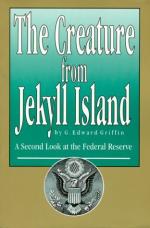
|
| Name: _________________________ | Period: ___________________ |
This test consists of 5 multiple choice questions, 5 short answer questions, and 10 short essay questions.
Multiple Choice Questions
1. What portion of the U.S. debt did a large portion of the tax dollar pay for?
(a) The U.S. debt continued to grow with a large portion of tax dollar going into paying only the interest on the debt.
(b) The U.S. debt continued to grow with a large portion of tax dollar going to entitlement programs.
(c) The U.S. debt continued to grow with a large portion of tax dollar going into paying the principal on the debt.
(d) The U.S. debt continued to grow with a large portion of tax dollar going to US war efforts.
2. What debt would be incurred by future generations from currency devaluation?
(a) National debts were paid right away from the currency devaluation and only deficits would be inherited by future generations.
(b) National debts were paid right away from the currency devaluation and only national growth expenses would be inherited by future generations.
(c) National debts were paid right away from the currency devaluation and only interest payments would be inherited by future generations.
(d) National debts were paid right away from the currency devaluation and only debts to foreign investors would be inherited by future generations.
3. Why was the language of the Federal Reserve Act kept intentionally vague?
(a) The language in the bill was made intentionally vague so that the US could remain the world's strongest economy.
(b) The language in the bill was made intentionally vague so that the general public would be kept in the dark about its powers.
(c) The language in the bill was made intentionally vague to protect national security.
(d) The language in the bill was made intentionally vague and open to future interpretations.
4. What caused England to nearly go broke?
(a) The British pound suffered in the European market, which led to the country nearly going broke.
(b) The British pound suffered in the US market, which led to the country nearly going broke.
(c) The British pound suffered in the international markets, which led to the country nearly going broke.
(d) The British pound suffered in the Asian market, which led to the country nearly going broke.
5. What document did the author provide to support the idea of a conspiracy to destroy the U.S. economy?
(a) The author used a confidential report found in Congressional archives to support the idea of conspiracy to destroy the US economy.
(b) The author used a document named the Report from Iron Mountain to support the idea of conspiracy to destroy the US economy.
(c) The author used the minutes of secret Jekyll Island meeting to support the idea of conspiracy to destroy the US economy.
(d) The author used a document obtained by the CIA to support the idea of conspiracy to destroy the US economy.
Short Answer Questions
1. What place in history does the Rothschild family hold?
2. What decade marked the beginning of a tremendous surge in U.S. debt?
3. What did the author predict would become the world government?
4. What occurred after the economic downturn in 1818?
5. Why was the use of fiat money disallowed in the United States?
Short Essay Questions
1. According to Chapter 17, what dispute did President Andrew Jackson have with the leader of The Second Bank?
2. According to Chapter 9, what culture first developed the the modern equivalent of the banking industry?
3. In Chapter 12, what were the sales of English and French war bonds used for?
4. In Chapter 10, what resulted from the Mandrake Mechanism?
5. According to Chapter 14, how many revolutions did Russia actually undergo?
6. According to Chapter 13, what was the goal of the secret society founded by Lord Alfred Milner?
7. In Chapter 9, what restrictions were placed on the Bank of Amsterdam which was established in 1609?
8. According to Chapter 19, what were the causes of the Civil War?
9. According to Chapter 22, when was the Federal Reserve Act passed?
10. According to Chapter 12, what event sparked the conflicts that led to World War I?
|
This section contains 1,103 words (approx. 4 pages at 300 words per page) |

|




